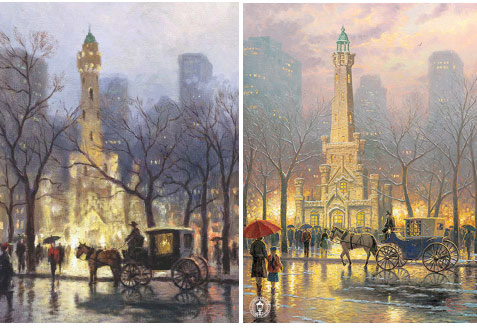 On one level, it's easy to note that media coverage of the unexpected death of faith-based superstar artist Thomas "Painter of Light" Kinkade has moved past the early headlines and into an all-to-familiar second stage that is very popular with the mainstream press. I am referring to the fallen evangelical superstar with secrets stage.
I promise not to dwell on this tawdry scene, because I want -- once again -- to try to focus on some of the religion-news questions linked to his career and work. For example, this pair of related questions: Was this man an evangelical? Is that the best label journalists can use to describe his beliefs?
On one level, it's easy to note that media coverage of the unexpected death of faith-based superstar artist Thomas "Painter of Light" Kinkade has moved past the early headlines and into an all-to-familiar second stage that is very popular with the mainstream press. I am referring to the fallen evangelical superstar with secrets stage.
I promise not to dwell on this tawdry scene, because I want -- once again -- to try to focus on some of the religion-news questions linked to his career and work. For example, this pair of related questions: Was this man an evangelical? Is that the best label journalists can use to describe his beliefs?
But first, here is the obvious update care of The Daily:
Rescue workers who raced to Thomas Kinkade’s California home on the morning the painter died were responding to a call of a unconscious, 54-year-old man who had been “drinking all night,” The Daily has learned.
A Santa Clara County dispatcher can be heard on a recording at 11:16 a.m. Friday describing that call as a “54-year-old male, unconscious, not breathing. Apparently he has been drinking all night and not moving ... CPR in progress.” County officials would not comment.
Kinkade’s live-in girlfriend, Amy Pinto, 48, who made the call, told the San Jose Mercury News that he “died in his sleep, very happy, in the house he built, with the paintings he loved, and the woman he loved.”
Kinkade, the self-proclaimed “Painter of Light,” built the world’s most profitable art empire from his idyllic, often religious work. But his company was in bankruptcy and he had well-publicized problems with alcohol. Two years ago, he was sentenced to 10 days in jail for drunken driving.
Yes, the local police had responded to earlier calls about fights between the painter and his girlfriend. It's safe to predict future coverage.
Yes, Kinkade and his wife, Nanette, are legally separated. That sounds like an arrangement linked to financial complexities and the raising of their four daughters. It's safe to predict future coverage.
Yes, there is the matter of the delayed toxicology report after the autopsy. I would expect coverage of that angle, as well.
None of which, particularly, sounds like GetReligion territory (although I could be wrong).
No, here is the section of The Daily story that interested me, in terms of future coverage about this artist and the content of his art and faith.
... Kinkade, the mainstream’s most beloved modern painter, albeit often derided by critics, has left behind perhaps hundreds of unreleased paintings, sketches and writings, close friends told The Daily.
“He has things that nobody has ever seen that are beautiful, that are absolutely beautiful,” said Linda Raasch, who had known the late painter more than 25 years.
Raasch said his personal work is mostly in the en plein air style of French expressionism -- quick paintings that capture the ambiance of the light and air -- in contrast to his more popular, highly-detailed renditions of bucolic settings.
“He was brilliant, he was beyond talented. Far beyond what the public has ever seen,” Raasch said.
Kinkade had dreamed of having his work hang in a museum, perhaps being given an entire retrospective, while he was alive. The Kinkade Company, which licenses and distributes his work, has not decided how it will reveal his unreleased work, a spokesman said.
In other words, there were literally two Kinkades -- the private artist and the commercial artist. Check out the illustration at the top of this post for an early hint of what might emerge in the near future.
It seems that Kinkade's own personal view of the world was expressed in one style, while he chose to perfect a completely different style that allowed him to connect with consumers, many of whom were attracted to his work by his vaguely spiritual approach to life (lots of unrealistic light and sentimentality, almost zero interest in human forms or traditional religious symbols and themes).
I finished this article wanting to know the answer to some rather basic questions: What kind of religious content was found in his REAL art? Does this content offer any clues to the faith of the REAL Kinkade? Was he a sincere believer with real problems? Was any of this struggle reflected in his work?
In other words, who was Thomas Kinkade? This would seem to be an important issue to be discussed in stories about Thomas Kinkade. Stay tuned.
IMAGES: This wonderful contrast of early Kinkade (left) with the work of the superstar Kinkade is an illustration from a Joe Carter piece at First Things in June of 2010. By all means check it out.
